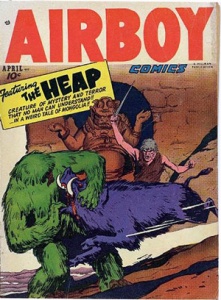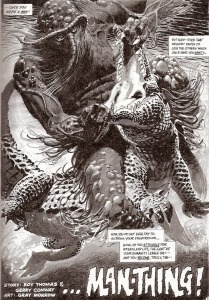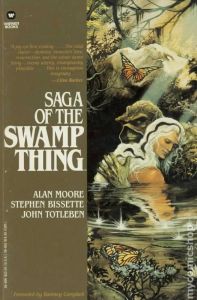“What if an American comic book company were to ring me up (not that it was going to happen) and they offered me my first U.S. assignment, only it was the most obscure, uninteresting character I could imagine? So let’s, out of the blue, pick the most obscure American comics character I could think of and just see if I could reinterpret him and make him interesting.”
That’s Alan Moore describing himself, just before an American comic book company really did ring him up. It was DC editor Len Wein offering him a shot at Swamp Thing.

Weirdly, the “most obscure American comics character” Moore had practiced on was The Heap—the 1940s character Wein had knocked-off to create Swamp Thing in 1971.
The character type was oddly popular in the early 70s. Roy Thomas had been a Heap fan as a kid, and so when he got a staff writer job at Marvel, he created the Heap-like Glob for The Incredible Hulk #121 in 1969.
A year and a half later, Skywald comics resurrected the original Heap.
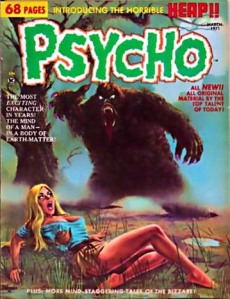
Thomas had told his pal, former Marvel employer and Skywald co-founder Sol Brodsky, it was a good band wagon to jump on since Marvel had its own Heap knock-off, Man-Thing. Stan Lee dreamt up that name, but apparently the Glob was all the regurgitated Heap that Thomas could swallow, so he handed the assignment to scripter Gerry Conway. Gray Morrow’s drawings even include a visual homage to the Heap’s vine-like nose in Savage Tales #1 (May 1971).
Thomas tossed the next Man-Thing assignment to Len Wein and Neal Adams who worked up a second episode, but Marvel cancelled Savage Tales after the first issue. Wein also freelanced at DC where he created Swamp Thing with artist Bernie Wrightson for House of Secrets #92 (June–July 1971). It took another year, but the Wein-Adams Man-Thing eventually surfaced in Astonishing Tales #12 (June 1972), just a few months before Wein and Wrightson updated their House of Secrets Swamp Thing for DC’s Swamp Thing #1 (October–November 1972).
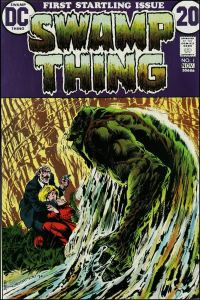
That’s a murky swamp of overlapping characters and creators to sift through. Worse, Wein and Conway were sharing an apartment at the time, and yet Wein swore Swamp Thing had nothing to do with Man-Thing—even though Man-Thing’s premiere is dated a month before Swamp Thing’s.
Thomas’s timetable doesn’t add up either: Skywald’s Heap premiered in Psycho #2 March 1971, three months before Man-Thing in Savage Tales #1. Add in the unknowable differences in production time, and the quagmire keeps deepening.
Neither Marvel nor DC tried to sue the other for copyright infringement, since both their characters were infringing on the Heap that Harry Stein and Mort Leav created for Hillman Periodicals’ Air Fighters Comics #3 in 1942. But Stein and Leav don’t get original credit either, since the Heap looks a lot like Theodore Sturgeon’s short story “It,” published two years earlier in Street and Smith’s Unknown.
Wein says he conceived Swamp Thing in December 1970, but
“Why I decided to make the protagonist some sort of swamp monster . . . I can no longer recall. . . . Coincidentally, Joe [Orlando, then-editor of THE HOUSE OF MYSTERY and THE HOUSE OF SECRETS] had been thinking of doing a story along the lines of Theodore Sturgeon’s classic fantasy tale ‘It’ . . . a story I had actually never read.”
And the swamp goes full circle when Roy Thomas scripted Marvel’s “It” adaptation for Supernatural Thrillers #1 (December 1972).

Sturgeon was invited to the 1975 San Diego Comic Convention so Ray Bradbury could hand him a Golden Ink Pot award. “I learned,” wrote Sturgeon, “for the very first time that my story ‘It’ is seminal; that it is the great granddaddy of The Swamp Thing, The Hulk, The Man Thing, and I don’t know how many celebrated graphics.”
The comic book swamp, however, was already draining, since Man-Thing was cancelled in 1975, and Swamp Thing the year after. It’s hard to explain the initial rise, though it probably has something to do with the 1971 change in the Comics Code:
“Vampires, ghouls and werewolves shall be permitted to be used when handled in the classic tradition such as Frankenstein, Dracula, and other high calibre literary works written by Edgar Allen Poe, Saki, Conan Doyle and other respected authors whose works are read in schools around the world.”
The Heap, after all, is a reanimated corpse. Though the cause of that reanimation is as murky as Swamp Thing’s creative origins. Is “the unearthly transformation” because World War I German pilot Baron Emmelmann’s “will to live” is such a “powerful force” that it merges his body with the slime and vegetation of the Polish swamp where his plane crashed, causing him to rise two decades later as “a fantastic heap that is neither man nor animal”? If so, why does the Heap “die” two issues later, only to be reanimated by a nefarious zoologist’s “serum”? And what does that mysterious serum have to do with “Ceres, Goddess of Soil,” who in 1947 is retconned (by an uncredited writer) into the origin, raising the dead pilot as an agent of peace in defiance of the god Ares?
Alan Moore did an even deeper retcon to Swamp Thing. Instead of a man transformed into a plant, the 1984 Swamp Thing is a plant transformed into a man.
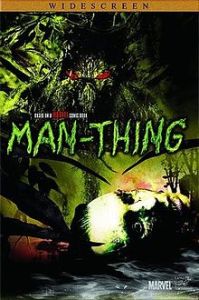
The 2005 Man-Thing movie (it apparently was intended to be theatrical release before demoted to the Syfy channel) goes for supernatural agency, though the Lee-Thomas-Conway-Morrow original was pure scifi: the inventor of a super-soldier serum injects himself and crashes his car into a swamp to keep the serum from the bad guys. The “formula”—updating Captain America’s premise for the Vietnam-era—is apparently napalm-based (a newspaper headline reads “NAPALM BOMB” as the inventor laments: “It’s bad enough the chemical will be used for more killing”), and so Man-Thing’s touch burns. Or it did until the second episode, when Wein decided it only burns those who feel fear because . . . that’s how napalm works? Steve Gerber ran with that non-scifi premise, mixing more supernatural agency into his revised swamp, which, it turns out, is really a doorway to multiple dimensions.
Although Man-Thing hasn’t been lying completely dormant for the last few decades, I’d say he’s still a descent contender for the current “most obscure, uninteresting comic book character” category. Or at least a mindless, shuffling heap of muck that reflexively burns people who are afraid isn’t a superhero high on Marvel Entertainment’s film and TV project list. Like Thomas for the Heap though, I have a squishy spot in my heart for him. So let me take on Alan Moore’s thought experiment, and see if I can “reinterpret him and make him interesting.” Or maybe the problem is Man-Thing is already too interesting? So my assignment is to cover his range of weirdness while sticking to a single, scifi-only premise.
I’m placing my swamp near New Orleans and staffing it with weapon designers. Instead of napalm and super-soldiers, it’s a burning black plasma that swirls and geysers when in contact with a remote control beacon, incinerating everything else it touches. But to be practical in the field, you’d need a live soldier to operate it. So the new design is a hazmat body suit with direct neural interface. The head gear includes two large red “eyes” and tubes down the nose and sides. Things are going great until the suit-tester starts getting nervous. As his vitals rise, the plasma hits new levels of heat and mobility. It starts burning through the suit, and before they can shut it down, it incinerates him, leaving only a blackened skeleton and gas mask. But since the plasma is encoded with the last neural input, it’s now moving on its own, splashing and lurching around the complex with its puppet of a charred corpse. When it breaks outside, it vanishes into the swamp, where the plasma merges with the muck and bonds around the skeleton. What emerges isn’t sentient. It’s not even alive. It just roams randomly or sits dormant until its eyes glow red with internal heat when it senses human fear—which it then extinguishes with its burning touch.
The original Conway script includes a scantily-clad female spy who betrays the inventor and then later gets her face burnt off by Man-Thing—so let’s please avoid that double dose of misogyny. Maybe the inventor is the woman this time, and the guy testing the suit is the spy who’s seduced her to steal the tech. His vitals spike because she’s about to find him out—so it’s not just fear but his guilt too. To his own surprise, he really does love her, and it’s only his bursting into flame that prevents the discovery of his betrayal, giving his transformation a redemptive edge. Turning into a monster stops him from being a monster. And I’m betting at the end she’s the only one who can face him without fear, an act of forgiveness that also allows the plasma to finally shut down and Man-Thing to collapse into a puddle of mud and bones.
Okay, so maybe not the light PG-13 tone of the current Marvel movie universe, but what do you expect from a mindless, fear-burning swamp beast? I suggest Marvel use the character for a multi-episode subplot during season three of Agents of S.H.I.E.L.D, not unlike how they used Deathlok (another early 70s super-soldier monstrosity) in season one.
Now let’s see if anyone rings me up.
(Meanwhile, instead of sitting by his own phone, Swamp Thing is headed to Reykjavik, Iceland, for the International Popular Culture Association Conference at the end of July. Nathaniel Goldberg, a colleague from the Washington and Lee University Philosophy department, and I are presenting our paper, “Donald Davidson and the Mind of Swamp Thing.”)

